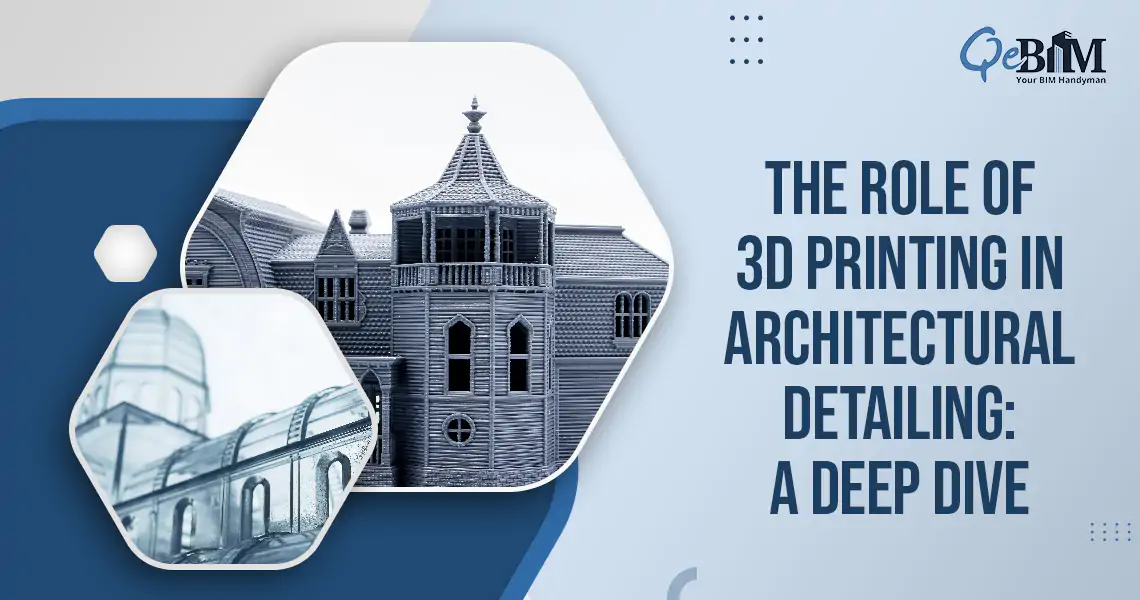The Role of 3D Printing in Architectural Detailing: A Deep Dive

In the early 2010s, 3D printing burst onto the architectural scene with the thunder of a revolution. Thinkers, designers and technologists envisioned a not-so-distant future where the buildings would rise from the massive printers like loaves from a futuristic oven.
Headlines roared about the 3D-printed houses in 24 hours, Mars habitats built by robots and cities shaped not by trowels or cranes but by the algorithms and even extruders.
But as the hype settled, something more grounded and far more transformative began to emerge.
And yet, here we are—more than a decade later—not living in 3D-printed skyscrapers but surrounded by the architectural detailing more precise, expressive and customized than ever before.
So, what happened?
Rather than disrupting the entire construction industry, 3D printing found its niche—quietly, elegantly and strategically in the domain of architectural detailing. And in doing so, it may have transformed the architecture more profoundly than anyone expected.
The Evolution: From Grand Promises to Grounded Precision
Initially, the 3D printing was seen as a monolithic disruptor—a bulldozer aimed at the entire construction process. But the real-world constraints like the material limitations, scalability and even the building codes clipped its wings. And what followed, however, was a graceful pivot.
The Architects and designers began using the 3D printing for the specific, high-impact elements like:
- Customized façade panels
- Intricate moldings
- Furniture and interior decors
- Prototypes and scale models
- Functional components like ventilation grills or even the light diffusers
These applications didn’t make headlines but they did revolutionize the workflows in the subtle yet powerful ways.
Real-Life Applications That Changed the Game
1) Zaha Hadid Architects – Morpheus Hotel, Macau
The building’s free-form, exoskeletal façade challenged the traditional manufacturing. 3D printing was used in the development of the interior elements and formwork for the complex concrete structures thereby allowing for a level of curvature and geometry that was previously unattainable.
2) ETH Zurich – DFAB House, Switzerland
ETH Zurich’s Digital Fabrication Group used the large-scale 3D printing to create a formwork for load-bearing concrete walls with the complex shapes. Rather than printing the walls themselves, they used 3D-printed molds which is an elegant example of how the 3D printing can augment rather than replace the traditional methods.
3) Gaudí’s Sagrada Família, Barcelona
Modern technology is helping complete Gaudí’s vision with the 3D-printed models used in the design and planning phases. The team uses the 3D printers to replicate and refine the intricate design details originally drawn by hand hence enabling the consistency with Gaudí’s unique organic style.
4) BIG’s “Twisting Tower” Prototype
Bjarke Ingels Group (BIG) explored modular concrete structures using the 3D-printed molds creating the twisting columns that interlock without the need for the adhesives. This application speaks volumes about the precision and modularity that 3D printing brings to the architectural detailing.
Why Architectural Detailing Was the Perfect Fit?
Architectural details are where creativity meets the execution. They demand accuracy, craftsmanship and often the mass customization. Traditional manufacturing falls short when faced with:
- Non-repeating forms
- Complex curvature
- Fast prototyping needs
- Budget constraints for the custom tooling
But 3D printing actually works best in these situations. With 3D Visualization Services, architects can ideate and iterate quickly The shift from virtual model to tangible prototype occurs effortlessly, reducing time, error and material wastages.
When combined with BIM Architectural Services, the 3D printing gets even better. The BIM models offers the data-rich geometry needed to print the precise components directly with the clash detection and optimization baked into the design process.
Blending the Old and the New
One of the most compelling outcomes of this shift has been the hybridization of the architectural craft. We’re now seeing:
- 3D-printed decorative panels that mimics handcrafted patterns
- Restorations of the historic buildings using scanned-to-print workflows
- Modular, personalized furniture for boutique hotels
- Rapid prototyping of spatial layouts for the client presentations
These applications bridge the past and the future thereby allowing the artisans and machines to collaborate rather than compete.
The New Norm: Quiet Innovation
3D printing may have started with bold claims of reshaping the architecture but its lasting legacy lies in the details. In fact, many of the most stunning contemporary buildings owe their signature touches to the 3D-printed elements that enhances the texture, light plays, and even the user experiences.
Architects aren’t abandoning their tools—they’re expanding them.
Final Thoughts
The journey of 3D printing in architecture tells a familiar story: true transformation doesn’t always come with the loud announcements. It often arrives in the form of improved workflows, smarter materials and quieter, more precise decisions.
By embedding itself into the DNA of architectural detailing, the 3D printing has done more than fulfilling its early promises—it has redefined everything that’s possible when art, engineering and technology converges.
From prototype to perfection, from bold to beautiful—3D printing has finally found its place.